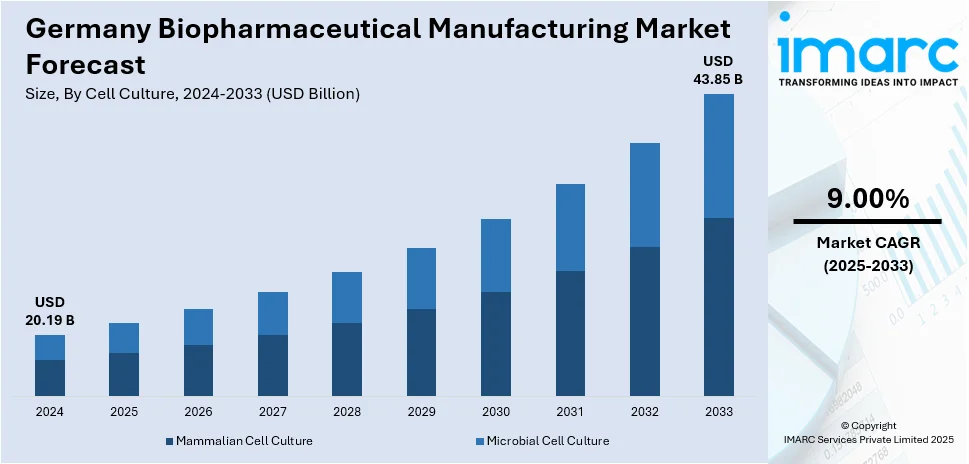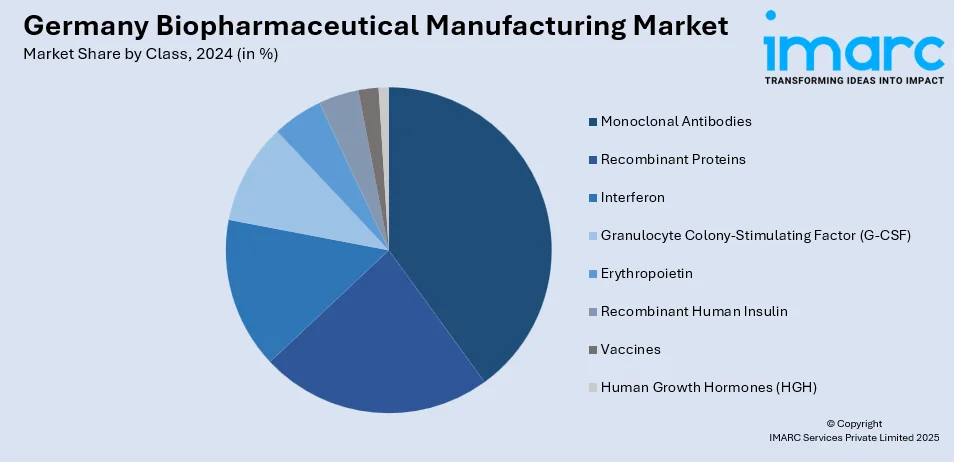
Germany Biopharmaceutical Manufacturing Market Size, Share, Trends and Forecast by Cell Culture, Class, and Region, 2025-2033
Germany Biopharmaceutical Manufacturing Market Overview:
The Germany biopharmaceutical manufacturing market size reached USD 20.19 Billion in 2024. Looking forward, IMARC Group expects the market to reach USD 43.85 Billion by 2033, exhibiting a growth rate (CAGR) of 9.00% during 2025-2033. The strong R&D investments, a robust healthcare system, and high demand for innovative drugs, generics, and biosimilars, fueled by an aging population, government regulations, and technological advancements, with key players expanding manufacturing and digital health solutions is augmenting the Germany pharmaceutical market share.
|
Report Attribute
|
Key Statistics
|
|---|---|
|
Base Year
|
2024
|
|
Forecast Years
|
2025-2033
|
|
Historical Years
|
2019-2024
|
| Market Size in 2024 | USD 20.19 Billion |
| Market Forecast in 2033 | USD 43.85 Billion |
| Market Growth Rate 2025-2033 | 9.00% |
Germany Biopharmaceutical Manufacturing Market Trends:
Advancements in Biotechnology
The increasing biotech ecosystem in Germany represents one of the key factors offering a favorable market outlook. A developed network of research institutions, universities, and innovation centers is promoting collaborations among industry participants, nurturing a culture of innovation and speedy progress. The growing focus on supporting biotech startups with various incubators and funding programs is enabling these companies to bring new biopharmaceuticals to the market. The collaboration between academia and industry is also facilitating cutting-edge research leading to useful applications, which is improving the development of new treatments. Furthermore, the presence of specialized talent in life sciences is ensuring that companies can navigate complex challenges in drug development and production, thereby fostering Germany pharmaceutical market growth. As per the IMARC Group’s report, the Germany biotechnology market size is expected to exhibit a growth rate (CAGR) of 10.70% from 2024 and 2032.

Rising Investments in Biopharmaceuticals
Increasing investments in biopharmaceutical manufacturing is positively influencing the market in Germany. Industry players are recognizing the potential of biopharmaceuticals to address pressing health challenges while using substantial resources for improving their capabilities. Companies are investing in state-of-the-art facilities and cutting-edge technologies that enable efficient and scalable production processes. This focus on innovations is streamlining development timelines and reducing costs, ultimately making biopharmaceuticals more accessible. Besides this, with the growing number of companies investing in research and development (R&D) activities and production, companies are improving their competitive advantage in the market. This is motivating new and existing businesses to seek out original ideas, leading to the ongoing development of biopharmaceuticals. As industry players are prioritizing investments, they are shaping the future landscape of the biopharmaceutical sector in Germany. This commitment to innovation and growth is benefiting individual companies and strengthening the overall market growth, which in turn is positively impacting the Germany pharmaceutical market outlook. For instance, in 2024, Merck, a leading global science and technology company, invested over €300 Million in a new research center at its global headquarters in Darmstadt, Germany. This investment is part of a broader approximately USD 1.573 Billion program aimed at accelerating biopharmaceutical product development by 2025. In addition, governing agencies of the country are offering grants and favorable regulations to facilitate a conducive environment for investments.
Germany Biopharmaceutical Manufacturing Market Segmentation:
IMARC Group provides an analysis of the key trends in each segment of the market, along with forecasts at the country level for 2025-2033. Our report has categorized the market based on cell culture and class.
Cell Culture Insights:
- Mammalian Cell Culture
- Microbial Cell Culture
The report has provided a detailed breakup and analysis of the market based on the cell culture. This includes mammalian cell culture and microbial cell culture.
Class Insights:

- Monoclonal Antibodies
- Recombinant Proteins
- Interferon
- Granulocyte Colony-Stimulating Factor (G-CSF)
- Erythropoietin
- Recombinant Human Insulin
- Vaccines
- Human Growth Hormones (HGH)
A detailed breakup and analysis of the market based on the class have also been provided in the report. This includes monoclonal antibodies, recombinant proteins, interferon, granulocyte colony-stimulating factor (G-CSF), erythropoietin, recombinant human insulin, vaccines, human growth hormones (HGH).
Regional Insights:
- Western Germany
- Southern Germany
- Eastern Germany
- Northern Germany
The report has also provided a comprehensive analysis of all the major regional markets, which include Western Germany, Southern Germany, Eastern Germany, and Northern Germany.
Competitive Landscape:
The market research report has also provided a comprehensive analysis of the competitive landscape. Competitive analysis such as market structure, key player positioning, top winning strategies, competitive dashboard, and company evaluation quadrant has been covered in the report. Also, detailed profiles of all major companies have been provided.
Germany Biopharmaceutical Manufacturing Market News:
- August 2024: Sanofi invested €1.3 Billion (USD 1.36 Billion) to expand its insulin production facility in Frankfurt, Germany, with the new site set to cover 36,000 m² and become operational by 2029, with support from the German government and the Hesse state government, subject to European Union (EU) approval.
- November 2023: US pharmaceuticals company Eli Lilly planned to invest €2 Billion (USD 2.09 Billion) in a new production plant in western Germany, marking its first major manufacturing site in the country. The new site will make diabetes drugs with the potential use to treat obesity.
Germany Biopharmaceutical Manufacturing Market Report Coverage:
| Report Features | Details |
|---|---|
| Base Year of the Analysis | 2024 |
| Historical Period | 2019-2024 |
| Forecast Period | 2025-2033 |
| Units | Billion USD |
| Scope of the Report | Exploration of Historical Trends and Market Outlook, Industry Catalysts and Challenges, Segment-Wise Historical and Future Market Assessment:
|
| Cell Cultures Covered | Mammalian Cell Culture, Microbial Cell Culture |
| Classes Covered | Monoclonal Antibodies, Recombinant Proteins, Interferon, Granulocyte Colony-Stimulating Factor (G-CSF), Erythropoietin, Recombinant Human Insulin, Vaccines, Human Growth Hormones (HGH) |
| Regions Covered | Western Germany, Southern Germany, Eastern Germany, Northern Germany |
| Customization Scope | 10% Free Customization |
| Post-Sale Analyst Support | 10-12 Weeks |
| Delivery Format | PDF and Excel through Email (We can also provide the editable version of the report in PPT/Word format on special request) |
Key Questions Answered in This Report:
- How has the Germany biopharmaceutical manufacturing market performed so far and how will it perform in the coming years?
- What is the breakup of the Germany biopharmaceutical manufacturing market on the basis of cell culture?
- What is the breakup of the Germany biopharmaceutical manufacturing market on the basis of class?
- What is the breakup of the Germany biopharmaceutical manufacturing market on the basis of region?
- What are the various stages in the value chain of the Germany biopharmaceutical manufacturing market?
- What are the key driving factors and challenges in the Germany biopharmaceutical manufacturing?
- What is the structure of the Germany biopharmaceutical manufacturing market and who are the key players?
- What is the degree of competition in the Germany biopharmaceutical manufacturing market?
Key Benefits for Stakeholders:
- IMARC’s industry report offers a comprehensive quantitative analysis of various market segments, historical and current market trends, market forecasts, and dynamics of the Germany biopharmaceutical manufacturing market from 2019-2033.
- The research report provides the latest information on the market drivers, challenges, and opportunities in the Germany biopharmaceutical manufacturing market.
- Porter's five forces analysis assist stakeholders in assessing the impact of new entrants, competitive rivalry, supplier power, buyer power, and the threat of substitution. It helps stakeholders to analyze the level of competition within the Germany biopharmaceutical manufacturing industry and its attractiveness.
- Competitive landscape allows stakeholders to understand their competitive environment and provides an insight into the current positions of key players in the market.
Need more help?
- Speak to our experienced analysts for insights on the current market scenarios.
- Include additional segments and countries to customize the report as per your requirement.
- Gain an unparalleled competitive advantage in your domain by understanding how to utilize the report and positively impacting your operations and revenue.
- For further assistance, please connect with our analysts.
 Request Customization
Request Customization
 Speak to an Analyst
Speak to an Analyst
 Request Brochure
Request Brochure
 Inquire Before Buying
Inquire Before Buying




.webp)




.webp)












